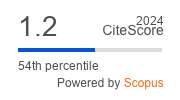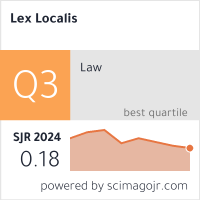Examining the Nexus Between Local Governance Structures and College Students’ Cultural Identity and Confidence-Take Zhejiang as an Example
DOI:
https://doi.org/10.52152/22.1.153-174(2024)Keywords:
local governance structure, Zhejiang Province, cultural identity, college students' self-confidenceAbstract
In order to give full play to the advantages of local governance structure, it is necessary to explore the influence of governance structure on college students' cultural identity and self-confidence. In this paper, a questionnaire survey was conducted on four college students in Zhejiang Province, and the regression analysis method was used to analyze the survey data. Based on the results, from the perspective of local governance structure, the relationship between local governance structure and college students' cultural identity and self-confidence is demonstrated. This paper puts forward the following hypotheses: first, whether the structure of local autonomy has an impact on the cultural identity of college students; second, whether the relationship between college students' identity and self-confidence is independent; thirdly, whether the local self-control structure can improve the self-confidence of college students; Finally, the influence and degree of local self-government structure and cultural identity of college students on college students' self-confidence. The results show that the local structure can improve the cultural level of college students, with an increase of about 10.5%, and the impact on the cultural self-confidence of college students is relatively small, indicating that there is a correlation between cultural identity and local governance structure, and the correlation between cultural self-confidence is small, and the relationship between cultural identity and self-confidence is independent. The reason for this is that the short-term effect of the local governance structure is significant, and the long-term effect is not good, so it is necessary to cooperate with social participation measures, university system and other measures to enhance students' cultural self-confidence.
References
Abbas, A., Zhang, G.Q., Bilal & Chengang, Y.G. (2023) Firm governance structures, earnings management, and carbon emission disclosures in Chinese high-polluting firms, Business Ethics the Environment & Responsibility, 32(4), pp. 1470–1489.
Callanan, G., Tomkowicz, S.M., Teague, M.V. & Perri, D.F. (2023) Juxtaposing the "shareholder" and "stakeholder" views of corporate governance: a pedagogical structure for classroom discussion, Journal of International Education in Business, 16(3),pp. 247–265.
Conte, F., Sardanelli, D., Vollero, A. & Siano, A. (2023) CSR signaling in controversial and noncontroversial industries: CSR policies, governance structures, and transparency tools, European Management Journal, 41(2), pp. 274–281.
Esposito, G., Felicetti, A. & Terlizzi, A. (2023) Participatory governance in megaprojects: the Lyon-Turin high-speed railway among structure, agency, and democratic participation, Policy and society, 42(2), pp. 259–273.
Giovanini, A., Bertolini, L.B., Salm, V.M. & Bittencourt, P.F. (2023) Monitoring and control structure as a basis for innovation in governance: the taxigov case, Revista Do Servico Publico, 74(2), pp. 390–409.
Hasan, A., Riaz, Z. & Nakpodia, F. (2023) Explicating the contextuality of corporate governance through ownership structure and family management: evidence from an emerging economy, Corporate Governance-the International Journal of Business in Society, 23(5), pp. 1085–1104.
Kahraman, Y.E. (2023) The Effect of Ownership Structure on Capital Structure Decisions: Comparison of BIST 100 Companies and Corporate Governance Index Companies, Sosyoekonomi, 31(57), pp. 283–298.
Karuga, R., Kok, M., Mbindyo, P., Otiso, L., Macharia, J., Broerse, J.E.W. & Dieleman, M. (2023) How context influences the functionality of community-level health governance structures: A case study of community health committees in Kenya, International Journal of Health Planning and Management, 38(3), pp. 702–722.
Kim, S. & Sullivan, A. (2023) Connecting the composition of collaborative governance structure to community-level performance in homeless services, Public Administration Review, 83(4), pp. 734–749.
Leslie, M., Hansen, B., Abboud, R., Claussen, C., McBrien, K., Hu, J., Ward, R. & Aghajafari, F. (2023) Building a Data Bridge: Policies, Structures, and Governance Integrating Primary Care Into the Public Health Response to COVID-19, Annals of Family Medicine, 21(1), pp. 4–10.
Lim, S. & Young, S.L. (2023) Why the network coordinator matters: The importance of learning, innovation, and governance structure in coproduction networks, Journal of Civil Society, 19(1), pp. 94–118.
Mili, M. & Alaali, Y. (2023) Does corporate governance quality improve credit ratings of financial institutions? Evidence from ownership and board structure, Corporate Governance-the International Journal of Business in Society, 23(4), pp. 867–887.
Olaniyan, F.A. (2023) Filling the gaps in local governance in Henan Province: an analysis of the structure and process of informal community governance in Ibadan, Nigeria, Commonwealth Journal of Local governance,pp. 61–83.
Rosales, E.H. (2023) The Implications of Migration Governance and Colonial Structures in Humanitarian Organisations in Mexico, International Journal for Crime Justice and Social Democracy, 12(2), pp. 72–82.
Sharma, D., Alam, M.J., Begum, I.A. & McKenzie, A.M. (2023) Factors affecting the choice of governance structure along the vegetable value chain in Bangladesh, International Food and Agribusiness Management Review, 26(1), pp. 25–48.
Spithoven, A. (2023) Virtual Property and Governance Structures with Blockchain, Journal of Economic Issues, 57(2), pp. 466–475.
Steinberg, J. (2023) Structure and Context: A Multi-Level Approach to Supply Chain Governance, Annual Review of Political Science, 26, pp. 411–429.
Sun, Y.P., Gao, P.P., Raza, S.A. & Khan, K.A. (2023) The non-parametric causal effect of sustainable governance structure on energy efficiency and ecological footprint: A pathway to sustainable development, Gondwana Research, 121(2), pp. 383–403.
Wang, X. (2023) Collaborating in a centralized governance mechanism: structure and fragmentation of large-scale response coordination during the 2018 Typhoon Mangkhut in Shenzhen, International Journal of Emergency Services, 12(2), pp. 213–230.
Downloads
Published
Issue
Section
License
Copyright (c) 2024 Lex localis - Journal of Local Self-Government

This work is licensed under a Creative Commons Attribution-NonCommercial-NoDerivatives 4.0 International License.








